|
 Lactarius tawai Lactarius tawai
BiostatusPresent in region - Indigenous. Endemic
Images (click to enlarge)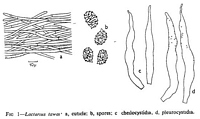 | 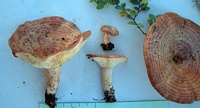
Owner: Karl Soop | 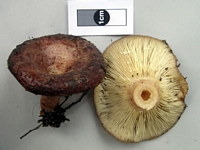
Owner: J.A. Cooper | 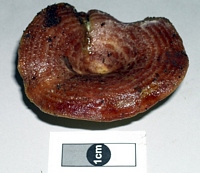
Owner: J.A. Cooper | 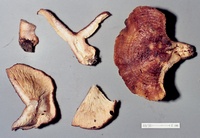
Caption: ZT69-038
Owner: E. Horak: © Creative Commons Attribution-Noncommercial 3.0 New Zealand | 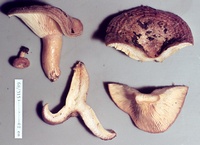
Caption: ZT68-315
Owner: E. Horak: © Creative Commons Attribution-Noncommercial 3.0 New Zealand | 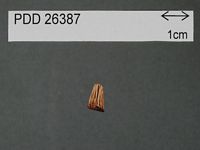
Caption: Dried type specimen
Owner: Herb PDD | 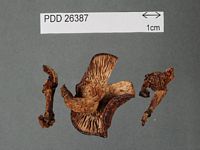
Caption: Dried type specimen
Owner: Herb PDD | |
Article: McNabb, R.F.R. (1971). The Russulaceae of New Zealand. 1. Lactarius DC ex S.F. Gray. New Zealand Journal of Botany 9(1): 46-66 (http://www.rsnz.org/publish/abstracts.php).
Description: pileus: 4-7.5 cm diam., convex when young, centrally depressed at maturity, moderately to heavily viscid particularly under wet conditions, glabrous or innately squarrose towards centre, distinctly or indistinctly concentrically zonate, ground colour sordid orange-brown or dingy ochraceous, concentric zones greyish purple, greyish vinaceous, or brownish red; margins moderately to strongly involute at maturity, entire, coarsely tomentose when young, not conspicuously so at maturity. Cuticle heavily gelatinised, composed of repent, interwoven, hyaline, thin-walled, septate hyphae l.5-4µm diam., and occasional lactiferous hyphae. lamellae:adnate to subdecurrent, crowded, thin, simple, or occasionally forked near stipe, to 4mm deep, pallid ochraceous with pink tints; lamellulae present in 2-3 unequal series; latex viscid, white, unchanging on exposure to air, drying pallid cream. stipe: 2-4 cm long, ±: equal or tapering basally, 1-1.8 cm diam., solid when young, chambered at maturity, dry or slightly viscid under wet conditions, glabrous, pallid orange-cream or yellowish cream, often with faint magenta or greyish violet tints; flesh brownish white, firm, unchanging. Cuticle similar to that of pileus. spores: spore print pallid creamy-white; spores broadly elliptical, obliquely apiculate, apiculus to l-(1.5) µm long, 7,5-9.6 X 5.5-8 µm, ornamentation of fine to moderately coarse amyloid ridges to I µm high forming an incomplete reticulum; plage indistinct. hymenium: basidia hyaline, clavate, 40-55 X 7-10.5 µm. 4-spored, sterigmata to 7 µm long; pleurocystidia scattered, narrowly ventricose-rostrate to fusiform, hyaline, thin-walled, contents refractive in KOH, not or only slightly projecting beyond basidia, 30-52 X 5-8.5µm, cheilocystidia subcylindrical or fusiform, often irregular apically, hyaline, thin-walled, 23-40 X 3.5-6.5 µm; pseudocystidia sparse, scattered, originating from lactiferous hyphae, irregularly cylindrical or apically strangulate, not or only slightly projecting beyond basidia, to 7.5 µm diam. hymenophoral trama: homiomerous, composed of connective hyphae and numerous lactiferous hyphae; subhymenium of closely interwoven, short-celled connective hyphae, appearing cellular in section. context of pileus: brownish to yellowish white, unchanging, firm, rather coarsely granular. smell: not distinctive. taste: lamellae slightly acrid; context mild. chemical characters: formalin - no reaction; phenol - slowly deep vinaceous; FeSO4- n.r.; guaiacol - slowly faint salmon pink; KOH on pileus - darkening with brick red tints; on context - n.r.; NH4OH on pileus and context - n.r.
Habitat: Solitary or gregarious under Nothofagus
Notes: Lactarius tawai can readily be accommodated in sect. Lactarius sub sect, lnsulsini stirps Insulsus, as defined by Singer (1962). In their treatment of North American Lactarii, Hesler and Smith (1960) transferred a number of species included in sect. Lactarius by Singer (1962) to the new sections Scrobiculatus and Crocei. The species of stirps Insulsus were not redisposed in this work,
Lactarius tawai may be recognised by the viscid, concentrically zonate pileus and the pink tinted, pallid ochraceous lamellae. It is the only species found in New Zealand with a zonate pileus.
|